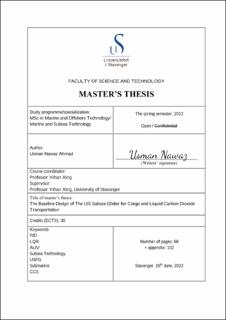| dc.description.abstract | This dissertation presents the baseline design of the UiS subsea-freight glider (USFG) for cargo
and liquid carbon dioxide transportation. The USFG is a cutting-edge autonomous vessel
developed to be an alternative to active transportation technologies and satisfy the demands of
small-scale fields for CO2 transportation. Usually, these smaller fields fail to economically
justify the costs of large tanker or cargo ships or underwater pipelines on the seabed, as the
transport volume is nominal compared to larger fields. The USFG can travel underwater at an
operational depth of 200 meters, allowing the glider to carry freight operations without
considering ideal weather windows. The length of the USFG is 5.50 meters, along with a beam
of 50.25 meters, which allows the vessel to carry 518 m3 of CO2 while serving the storage
needs of the carbon capture and storage (CCS) ventures on the Norwegian continental shelf. It
can maneuver itself underwater by monitoring the flow between the ballast tanks. During the
entire mission of the USFG, from capturing to injection locations, it follows a pre-laid route
while experiencing transient loads from the ocean current. A planar mathematical model for
the analysis of equilibrium glide paths of the USFG is presented. The model is developed using
Simscape Multibody in MATLAB/Simulink to study the volatile dynamics of the glider.
Subsequently, the gliding paths of USFG in the vertical plane are analyzed along with the
observability and controllability of the steady equilibrium glides. Along with the control
gliding design of the USFG, the mechanical design is also presented in this work. The
maneuvering model of the USFG is presented along with two operational case studies: the
equilibrium glide and the -38° dive. The extreme motion along the surge direction affects the
range of the glider (vital for battery design) and the dynamic controller parameters concerning
maneuverability. Finally, the averaged conditional exceedance rate (ACER) is employed to
scrutinize the extreme motion (surge direction) of the USFG while gliding to a defined depth.
This analysis is done when the glider is exposed to an average current velocity of 0.5 m/s and
1.0 m/s. The presented ACER method efficiently uses the available data points and accurately
predicts the extreme surge responses precisely and accurately. | |
